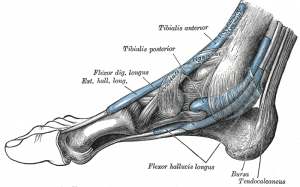- Mon-Fri: 10AM- 5PM Sat: 10AM-2PM
- 1300 886 668
- drtsai@meridian-health.com.au
Can Acupuncture Be Used As A Treatment For Tendonitis?
Tendinitis is a common injury that occurs to tendons, typically due to repetitive action, such as raking or cleaning. The tendon is a thick cord-like structure that attaches bones to muscles. When a repetitive action strains that tendon, it becomes inflamed and irritated, causing pain and discomfort. Other causes for tendonitis include arthritis, gout, and adverse reactions to certain types of medicine.
Tendinitis is the cause for more than half of Workman’s Compensation complaints, representing 56% of claims. The type of pain associated with tendonitis includes tenderness at the point of injury, numbness, tingling, and stiffness. Sometimes the joint will swell and remain sore long after the injury has healed.
Tendinitis isn’t just work or exercise-related, as tendons tend to lose elasticity with age. Although any tendon in the body can become inflamed and sore, tendinitis mostly affects the shoulders, heels, elbows, and wrists. The inflammation can even cause an infection within the tendon sheath (tissues).
A Miracle Cure?
Since a 1990 study in The Clinical Journal of Pain has come to light, acupuncture has been hailed as an incredibly useful treatment for the symptoms of tendinitis. The study revealed that participates who suffered from shoulder tendinitis had their pain reduced considerably, as well as be able to return to daily activities, move their shoulder, and regain strength after a single acupuncture treatment.
Acupuncture needles are inserted near or at the source of injury, forearm, and wrist. This deals with the pain and brings healing by restoring circulation to the area. Usually, a point of chi helps to heal an area that is blocked up by negative energy, which causes the swelling. When needles are placed at the point of the injury, correcting the disharmony in the body, the flow improves.
What is Acupuncture?
Acupuncture is a means of health care developed in China over 2,500 years ago! The idea is the body contains numerous energy flows necessary for proper health. When this flow is disturbed, it’s known to cause pain and disease. That’s where acupuncture comes in, it helps to correct the flow issues and restore the balance of energy.
Acupuncture was mostly unheard of in western medicine until 1972 when President Nixon took a trip to China. Since then, the interest in the U.S. and Europe in this ancient tradition has exploded. The types of acupuncture vary depending on the Asian country where it originated, usually China, Japan, and Korea, all having their own take on the practice.
Science has begun to catch up with long-held theories of the usefulness of acupuncture to treat pain. Studies conducted in both animals and humans have shown that the use of needles cause a response biologically. These responses are actually affected by the sensory neurons in the brain and central nervous system.
With the levels of chronic pain and tendonitis skyrocketing and the overdose of pain medications becoming a world-wide epidemic, it’s leaving many millions of people searching for alternative ways to deal with these issues. As science begins to catch up and even admit there is a basis for the circulation of energy in our bodies and the ability of needles to help heal from injuries, it’s no wonder why acupuncture has grown in popularity over the decades.


